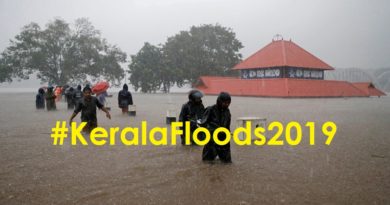This is not the future we want | Ashish Kothari
NITI Aayog’s strategy for 2022 is replete with environmental and livelihood related contradictions
In what appears to be draft zero of the BJP’s election manifesto, NITI Aayog released the ‘Strategy for New India @ 75’ document in 2018. This high-sounding and aspirational strategy aims to achieve a ‘New India’ by 2022, when the country celebrates its 75th year of Independence.
The strategy has many progressive objectives. It follows the UN Sustainable Development Goals. Inclusion, sustainability, participation, gender equality and other buzzwords find mention. A cursory reading would evoke widespread appreciation.
But these documents can’t be read cursorily. We need to unearth what’s hidden in their depths. Is there a consistent and well-thought-out strategy to meet the objectives? Are there contradictory elements that could defeat the objectives? Are there hidden motivations, not so benign? On one such reading of India @ 75, focusing on ecological and related livelihood concerns, there is serious doubt as to whether the ‘New India’ this strategy envisages will be any different from the crisis-ridden society we are today.
There are positive directions vis-à-vis the environment, such as a major focus on renewable energy, organic farming (with the zero budget natural farming model developed by Maharashtrian farmer Subhash Palekar being singled out for national application), increasing forest cover, and reducing pollution and waste. A chapter titled ‘Sustainable environment’ states: “The objective is to maintain a clean, green and healthy environment with peoples’ participation to support higher and inclusive economic growth through sustainable utilization of available natural resources.” It focuses on air pollution, solid waste management, water pollution, and forestry.
Many missing issues
It is puzzling why these four are singled out here, from amongst the much larger number of environmental issues India faces. Some other issues do find mention elsewhere, such as arresting land degradation and soil erosion, and water conservation. But many are missing, such as the urgent need to conserve a range of non-forest ecosystems. (Since colonial times, forests have remained predominant in the minds of decision-makers, as indicated by the fact that India still has only a Forest Department and no dedicated entity for grassland, marine and coastal, wetland, mountain, and desert conservation.) The increasing presence of toxic chemicals around us finds no mention. Most importantly, the absence of an integrated, comprehensive view on how ecological issues can be integrated into all sectors indicates that this is still not core to the mindset of our planners.
A reading of the rest of the document strengthens this conclusion. There is total absence of an understanding that the current form and goal of economic growth is inherently unsustainable. For more than three decades, governments have been promising that with environmental safeguards, growth can be made sustainable. There is no indication that this is anywhere near achievable, much less achieved. In 2008, the Confederation of Indian Industry indicated that India was already using twice of what its natural resources could sustain, and that more than half its biocapacity had already been eroded. Things are likely only worse now. No party in power has shown what magic wand it can use to suddenly make growth sustainable. Indeed, no country in the world has been able to do this. So it is alarming that the most important “driver” for the lofty goals of the strategy is economic growth.
Alarming features
Some readers may find this objection somewhat abstract. So here are other, more earthy examples of the internal contradictions in this document. One of the biggest ecological and social disasters in India is mining, especially the large-scale open-cast type. NITI Aayog ignores this when it proposes a doubling of the extent of mining. The only concession is the suggestion to bring in “cutting-edge” technology to “limit environmental damage”, as if that will solve the fundamental need to deforest areas. Another major sector with horrendous environmental impacts is tourism (never mind the ‘eco’ tag it comes with), as witnessed by virtually all our groaning hill stations and the ruin that areas like Ladakh, Kutch and the island regions are facing. Yet, NITI Aayog recommends doubling the number of domestic tourist visits to over 3,200 million from 1,614 million in 2016. It also urges prompt completion of a host of mega river valley projects that have proved to be ecological nightmares, including Pancheshwar in the fragile Himalaya, the Ken-Betwa link in Madhya Pradesh, and dozens in the Northeast that are going to choke up rivers and are being pushed ahead despite strong local opposition.
Nor, for all the mention of organic farming, is there a clear direction to phase out chemical fertilizers and pesticides. The agriculture chapters are in fact full of such fault lines. For instance, the objective of sustainable farming is undermined by the following: “Phase out old varieties of seeds and replace them with hybrid and improved seeds”. This is the kind of Green Revolution approach that has caused huge loss of agricultural biodiversity and resilience amongst small farmers. There is also no focus on dryland farming though most farmers are engaged in this. There is positive mention of organic farming models for replication, but nothing on the amazing work of dryland farmers (such as the Dalit women of the Deccan Development Society in Telangana) showing productive, sustainable, biodiverse agriculture with millets and women as the fulcrum.
One of the most alarming features of the document is its stress on rapid, single-window clearance of infrastructure and other projects. Any decent ecological assessment of a project needs a year of study (over all seasons), so the 180 days limit it suggests will mean short-cuts. This rush also means compromising on crucial processes of social assessment, public hearings, and participatory decision-making, as already seen in the last few years. There is nothing on the need to seek consent from local communities, though this is mandated under the Forest Rights Act, 2006, and the Panchayat (Extension to Scheduled Areas) Act, 1996.
Governments in the last few years have a dismal record of safeguarding the environment and the livelihoods of Adivasis and other communities. They have found ways to bypass constitutional and policy safeguards these vulnerable sections are supposed to enjoy. Without a strong, unambiguous commitment to upholding these protections, and putting communities at the centre of decision-making, India @ 75 is going to be an even more unequal, unjust, and conflict-ridden society than India @ 50. Is this the future we want? Or can we learn from the many alternative initiatives for food, water, energy, housing, education and health existing across India, which show the way to more just and sustainable livelihoods and ways of living?
Source: This article was originally published by The Hindu https://bit.ly/2T7if6X




